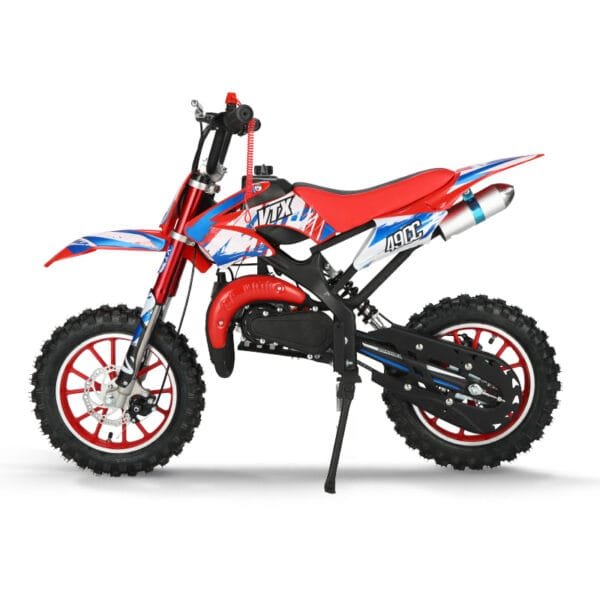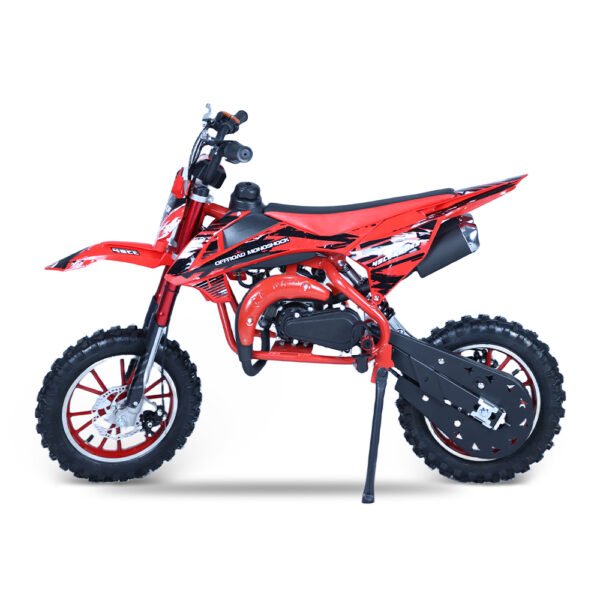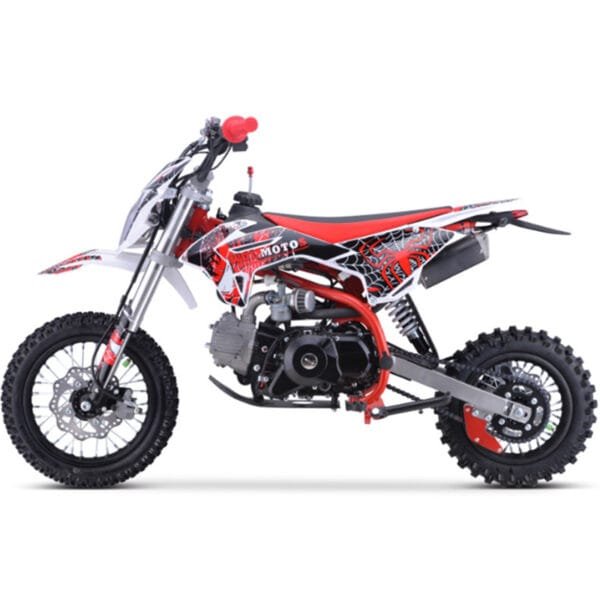
What are the Different Types of Dirt Bikes?
What are the Different Types of Dirt Bikes?
Dirt Bikes Introduction
Dirt biking has become an exhilarating and popular sport, providing an adrenaline-pumping escape from the monotony of everyday life.
With different terrains to conquer, from rugged trails to specialized tracks, understanding the various types of dirt bikes can make a world of difference.
Choosing the right one depends on where you ride, your skill level, and your specific goals.
Let’s explore the diverse types of dirt bikes and what sets them apart.
Motocross Dirt Bikes
Motocross bikes are designed with one main objective: high-speed racing on closed circuit tracks filled with jumps, turns, and other challenging obstacles.
These bikes are lightweight, powerful, and built to handle aggressive maneuvers.
They generally lack features like headlights, mirrors, and other road-legal components, focusing entirely on performance.
Key Features:
- Lightweight construction for agility
- High-performance suspension for big jumps
- Knobby tires for maximum grip on dirt tracks
- Strong acceleration and high torque
Advantages:
- Optimized for racing and high speeds
- Excellent handling on closed courses
- Designed for sharp turns and quick bursts of speed
Disadvantages:
- Not road legal
- Limited comfort for long rides
- High maintenance due to their performance-driven components
Trail Dirt Bikes
Trail dirt bikes, unlike motocross bikes, are tailored for navigating off-road trails and challenging terrains such as rocks, roots, and steep inclines.
They typically have a softer suspension and a more comfortable seating position to cater to long hours of off-road exploration.
Distinctive Features:
- Softer suspension for shock absorption on rough terrain
- Longer fuel range for extended trips
- Wider tires for better stability
- Lightweight frame but durable construction
Pros:
- Built for versatility on various terrains
- Easier to ride for extended periods
- Generally easier to maintain than motocross bikes
Cons:
- Slower compared to motocross bikes
- May lack specialized performance on tracks
Enduro Dirt Bikes
Enduro bikes are built for endurance riding across varied and challenging terrains.
These versatile machines blend elements of both trail bikes and motocross bikes to handle rocky paths, deep mud, steep inclines, and even road riding in some cases.
Typical Features:
- Long-travel suspension for rugged paths
- Powerful engines capable of enduring lengthy rides
- Equipped with headlights and sometimes turn signals
Benefits:
- Ideal for long-distance off-road adventures
- Adaptable to both trails and road segments
- Stronger than trail bikes and optimized for rougher riding
Drawbacks:
- Heavier than motocross bikes
- May not perform as well on a race track
Dual-Sport Dirt Bikes
Dual-sport dirt bikes are the perfect blend of off-road capability and street legality.
These bikes allow riders to transition from highways to trails with minimal fuss.
They are equipped with road-legal essentials like mirrors, turn signals, and license plate mounts while maintaining off-road prowess.
Key Aspects:
- Street-legal features for road usage
- Durable frame with off-road suspension
- Versatility for both pavement and dirt trails
Advantages:
- Flexible usage on and off-road
- Great for daily commuting and weekend trail adventures
- Excellent choice for riders who want one bike for multiple terrains
Considerations:
- Heavier than off-road-only bikes
- Compromises in high-performance off-road riding
Adventure Dirt Bikes
Adventure bikes are designed for long-distance travel over a mix of terrains.
They often resemble larger dual-sport bikes but offer superior comfort and more storage options, making them ideal for adventure touring.
These bikes have larger engines, making them suitable for highway travel and off-road exploration.
Features and Comfort Factors:
- Large fuel tanks for extended travel
- Ergonomically designed for comfort on long rides
- High-performance suspension for varying terrains
Pros:
- Excellent for long-distance travel
- Comfortable for long rides with plenty of cargo capacity
- Capable on both highways and trails
Cons:
- Heavy and challenging for technical off-road riding
- Expensive compared to other dirt bike types
Trials Bikes
Trials bikes are a unique breed of dirt bikes, specifically built for trials riding—a skillful sport that requires balance, control, and precision as riders navigate through challenging obstacles such as rocks, logs, and steep inclines.
Unlike other dirt bikes, trials bikes are not about speed but rather technique.
Unique Design Elements:
- Extremely lightweight and compact
- No seat or minimal seating to encourage standing riding position
- Low gearing for precise control
- Highly responsive suspension for stability over obstacles
Pros:
- Perfect for improving riding skills and balance
- Very lightweight, making them easier to handle
- Ideal for technical challenges and practice sessions
Limitations:
- Not suited for high-speed riding or racing
- Limited comfort due to lack of a proper seat
- Specialized use, limiting their versatility for broader riding needs
Mini Dirt Bikes (Pit Bikes)
Mini dirt bikes, commonly known as pit bikes, are smaller versions of standard dirt bikes.
Originally used for getting around the pits at motocross events, these bikes have gained popularity as beginner-friendly bikes and for casual recreational use.
Core Features:
- Smaller frame and engine size (often 50cc to 150cc)
- Lightweight and easier to maneuver
- Designed for younger or beginner riders, but also popular among adults for pit racing
Target Riders:
- Children and teenagers learning to ride
- Adults seeking a compact, fun bike for casual riding
Advantages:
- Excellent for teaching new riders
- Lightweight and easier to control for beginners
- Great for indoor and backyard tracks
Potential Limitations:
- Limited power and speed compared to full-size bikes
- Not ideal for challenging off-road terrain
- May require frequent maintenance for racing use
Electric Dirt Bikes
As electric technology continues to evolve, electric dirt bikes are making waves in the dirt biking community.
These bikes provide a quieter, more environmentally friendly option for off-road enthusiasts.
While they may not have completely replaced gas-powered dirt bikes yet, they are gaining traction for their unique benefits.
Benefits of Electric Power:
- Virtually silent operation, minimizing noise pollution
- Instant torque delivery for responsive riding
- Reduced maintenance compared to internal combustion engines
- Eco-friendly with zero emissions
Current Limitations:
- Limited battery range compared to fuel tanks
- Longer recharging times
- Higher initial cost in some cases
Developments in the Market:
- Improved battery life and fast-charging options
- Increasing popularity in youth and beginner segments
- Competitive models for racing are emerging
Choosing the Right Dirt Bike for You
With such a variety of dirt bikes on the market, choosing the right one can feel overwhelming.
However, focusing on your specific needs, experience level, and riding preferences can help you make a more informed decision.
Key Factors to Consider:
- Skill Level: Beginners should opt for manageable bikes, such as trail or mini dirt bikes, while experienced riders can explore motocross or enduro options.
- Intended Usage: Are you looking to race, explore trails, or commute? This determines whether you should go for a motocross, enduro, dual-sport, or other type.
- Terrain: Different bikes excel on specific surfaces. For rough trails, consider trail or enduro bikes; for smooth tracks, motocross bikes reign supreme.
- Personal Goals: Think about what you want from the sport—racing, exploration, or skill mastery.
Safety Gear for Dirt Biking
Dirt biking, while thrilling, comes with its share of risks.
Wearing the right safety gear is crucial for minimizing injuries and enhancing your riding experience.
Here’s what you need:
Essential Items:
- Helmet: The most critical piece of safety gear. Opt for a DOT or Snell-certified helmet.
- Goggles: Protects your eyes from dust, mud, and debris.
- Gloves: Ensures a strong grip and protects your hands from blisters and impacts.
- Boots: Special dirt biking boots provide ankle support and protection from injuries.
- Body Armor: Chest protectors, knee pads, and elbow guards shield you from impacts.
Investing in high-quality gear not only keeps you safe but also enhances your confidence on the bike.
Maintenance Tips for Dirt Bikes
Proper maintenance ensures that your dirt bike stays in top shape, ready to conquer any terrain you throw its way.
Regular care can also extend the lifespan of your bike and optimize its performance.
Regular Maintenance Tasks:
- Oil Changes: Regularly change the engine oil and replace the filter as needed.
- Tire Checks: Inspect tires for wear and maintain proper tire pressure.
- Chain Lubrication: Clean and lubricate the chain to prevent wear and ensure smooth operation.
- Air Filter Cleaning: Clean or replace the air filter frequently to avoid dust buildup.
- Brake Checks: Test brakes regularly and replace pads when needed.
Long-Term Care Tips:
- Store your dirt bike in a dry and secure location.
- Regularly check for loose bolts and fasteners.
- Follow manufacturer-recommended maintenance schedules.
Environmental Considerations in Dirt Biking
Riding responsibly is crucial for protecting the environment and preserving trails for future generations.
Being mindful of where and how you ride can make a difference.
Minimizing Environmental Impact:
- Stick to designated trails and avoid cutting through vegetation.
- Respect wildlife and avoid riding through sensitive habitats.
- Consider using electric dirt bikes for quieter and greener riding.
Ethical and Responsible Riding:
- Be courteous to other trail users.
- Clean up after yourself and remove any waste.
- Support organizations that promote sustainable riding.
Dirt Biking for Beginners
Getting started with dirt biking can be both thrilling and daunting.
Beginners need to approach the sport with patience, practice, and a willingness to learn.
By understanding the basics and choosing the right gear, new riders can ease into the exciting world of off-road biking with confidence.
Tips for Getting Started:
- Choose the Right Bike: Opt for a bike that matches your height, weight, and skill level. Mini dirt bikes or entry-level trail bikes are great for beginners.
- Take a Training Course: Enroll in a dirt biking class to learn essential skills such as balance, braking, and navigating obstacles.
- Invest in Safety Gear: A good helmet, gloves, boots, and protective clothing are non-negotiable for your safety.
- Practice in Controlled Areas: Start on flat, open areas before moving to more challenging terrains. This allows you to focus on the basics without distractions.
- Learn Bike Maintenance: Familiarize yourself with basic maintenance tasks to keep your bike running smoothly and spot potential issues early.
Beginner-Friendly Bike Types:
- Mini Dirt Bikes: Lightweight and easy to handle, these are ideal for younger or less experienced riders.
- Trail Bikes: Designed for casual off-road riding, they offer comfort and stability, making them a popular choice for new riders.
Conclusion
In the world of dirt biking, there’s a bike for every rider, terrain, and purpose.
From the high-speed thrill of motocross bikes to the rugged durability of enduro machines and the versatility of dual-sport bikes, understanding the different types helps you make an informed decision.
Whether you’re a beginner learning the ropes or an experienced rider tackling tough trails, there’s a dirt bike out there to fit your needs.
Explore, experiment, and find the bike that brings out your best ride.
FAQs
1. What is the best dirt bike for beginners?
For beginners, trail bikes and mini dirt bikes are excellent options.
They are easier to handle, less powerful, and offer stability for learning the basics of riding.
2. Are electric dirt bikes as powerful as gas-powered ones?
Electric dirt bikes are catching up in terms of power and torque delivery, though they often have limitations in terms of battery life and range compared to gas-powered models.
Newer models continue to narrow the gap.
3. Can you use a motocross bike for trail riding?
Technically, you can use a motocross bike for trail riding, but it may not be the most comfortable choice.
Motocross bikes are optimized for tracks and may lack features like softer suspension, broader fuel range, and lower gearing suitable for trails.
4. How often should you maintain a dirt bike?
Regular maintenance is crucial and should include oil changes every 10-20 hours of riding, air filter cleaning, chain lubrication, and frequent tire and brake checks.
Refer to your bike’s manual for specific schedules.
5. What is the difference between trail bikes and enduro bikes?
Trail bikes are designed for general off-road use, focusing on stability and ease of use.
Enduro bikes are built for endurance racing across diverse terrains and often include features for both road and trail segments.



















Finnian
The information shared is of top quality which has to get appreciated at all levels. Well done…